Ghana - Togo - Benin: West Africa, Alive More Than Ever
(Top Comfort Discovery)
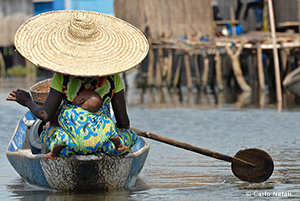
Duration: 15 days
Area: Ghana, Togo, Benin
Style: cultural tours
Comfort Level:![]()
![]()
![]()
![]()
![]()
Departures on request on any date.
Inclusion of festivals like Akwasidae / Awukudae will depend on date chosen.
Unique tour focused on the cultures and tribes living along the coastal and central regions of Ghana, Togo and Benin. In the heart of the voodoo country, we visit practitioners, watch trance-dances and learn about the great influence voodoo spirits still have on the people. We admire unique mask dances. We discover the Ancient kingdoms of Ketou, Dahomey and Ashanti, whose traditions are still strongly alive. We enter the Ashanti kingdom in Kumasi, probably the most important royal tradition in the entire continent. We explore the former Slave Coast, with its haunting European forts. We visit the cities of Cotonou, Lomé and Accra, with a special attention to the individual features of each. Great experience combined with “gentle” pace, good food and the best accommodation available.
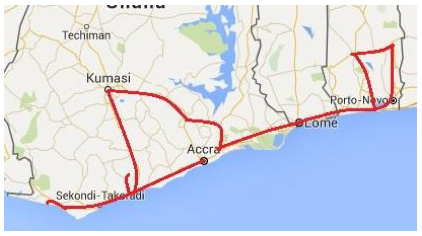
For travelers who want to get acquainted with this incredible region …
… and wish to do so at a gentler pace and with the best available comfort.
| Day 1 | Cotonou, Gulf of Guinea - BENIN |
| Day 2 | Villages on stilts, from Cotonou to Ketou - BENIN |
| Day 3 | Dancing masks, Ketou - BENIN |
| Day 4 | African kingdom, from Ketou to Ouidah - BENIN |
| Day 5 | Wild beaches & mask dances, Ouidah - BENIN |
| Day 6 | In Voodoo Land, from Ouidah to Lomé - BENIN & TOGO |
| Day 7 | Fetish market, from Lomé to Akossombo - TOGO & GHANA |
| Day 8 | Magic glass beads, Akossombo - GHANA |
| Day 9 | The Ashanti, from Akossombo to Kumasi - GHANA |
| Day 10 | Golden Kingdom, Kumasi - GHANA |
| Day 11 | Gulf of Guinea, from Kumasi to Elmina - GHANA |
| Day 12 | Rainforest, from Elmina to Kakum and Axim - GHANA |
| Day 13 | Lagoon, from Axim to Nzulezo and Axim - GHANA |
| Day 14 | Golden beach, from Axim to Accra - GHANA |
| Day 15 | African Metropolis, Accra out - GHANA |
Detailed Itinerary
Day 1: Cotonou, Gulf of Guinea - BENIN
Arrival in Cotonou (Benin) and transfer to the hotel.
Meals: lunch own arrangements; cocktail reception with hors d’oeuvres and welcome dinner
Overnight: Maison Rouge or similar (all rooms ensuite and with aircon, boutique hotel)
Day 2: Villages on stilts, from Cotonou to Ketou (180 km - 4 hr) - BENIN
We cross the Lake Nokwe with a motorized boat to reach Ganvie, the largest and most beautiful African stilt village. The approximately 25,000 inhabitants, of the Tofinou ethnic group, build their huts on teak stilts and cover the roofs with a thick layer of leaves. Fishing is their main activity. The village has managed to preserve its traditions and environment despite the long-lasting human presence in a closed setting; and the lake is not over-fished. Life unfolds each day around the canoes that men, women and children guide with ease using brightly colored poles. It is with these canoes that men fish, women deliver goods to the market and children go to school and play.

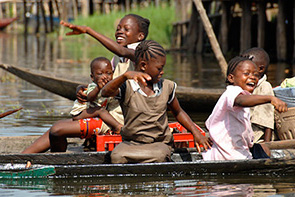

Meals: B - L - D
Overnight: Residence Céline or similar (all rooms ensuite and with aircon) - 3*
Day 3: Dancing masks, Ketou (50 km - 1 hr) - BENIN
If available, we will be received by His Majesty Alade Ife, the 50th Oba of Ketu, a large Yoruba kingdom in South Benin. Ketu is said to have been founded by Ede, son of Sopasan and grandson of Oduduwa, who ruled the Yoruba kingdom of Ile-Ife in Nigeria. The oba (meaning 'king' or 'ruler' in Yoruba language) will receive us in his royal palace, surrounded by his court. We will be granted the honour to talk to him and get to know a little more about his role of traditional chief in a modern state.
We will attend the amazing Gelede & Egun masks dances.
Gelede is at the same time a cult, a secret society and a mask. First of all, it is the cult of Oudua: the great divinity, the old mother and the mother earth. Gelede is also the daughter of Ougun, the god of iron and one of the main gods in South Benin’s Voodoo religion. But Gelede is also the secret society which holds the Gelede masks and organizes special dances. Gelede performances recall our western “theatre” where each mask represents a character, often humoristic or ironic. This theatrical aspect of the masks mimicking short stories has the function of educating, not simply entertaining the village. Gelede mask has feminine features but is worn by men dressed up like women and dancing incredible performances: a chorus made up of more than 20 singers dancing in a large circle with two big drums in the middle, the surrounding public, happy and excited, singing along, laughing and clapping hands. Colours dominate the scene with the dancers dressed up in colorful clothes moving around all the time. Indeed a fascinating mix of street theatre and magical theatre.

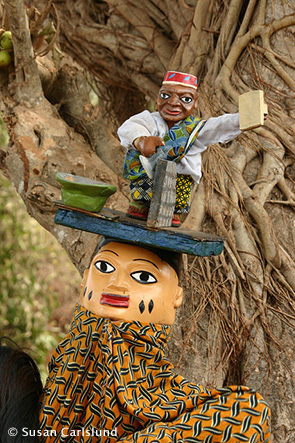
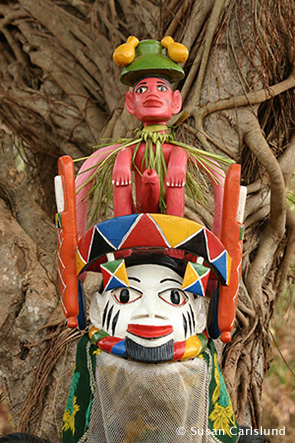
The Egungun is a very powerful masks secret society. Egun masks are the reincarnation of deceased people and are known and feared for their aggressiveness and their unpredictable way of moving around. Intensively coloured, masks are covered with a multitude of pieces of cloth of many red shades. They emerge from the forest and form a procession through the streets of the village, leaping towards any foolish spectator who dares getting too close. And nobody wants to be touched by the Egun because any contact carries the danger of death. Better watch out! When masks arrive they perform a kind of bull fight designed to scare the crowd but in truth they are actually greeted with bursts of laughter!
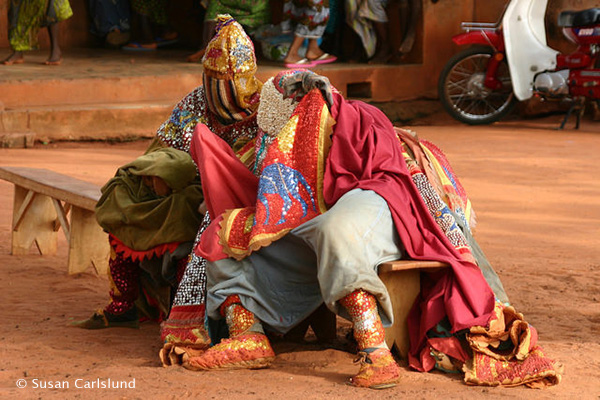
Meals: B - L - D
Overnight: Residence Céline or similar (all rooms ensuite and with aircon) - 3*
Day 4: African kingdom, from Ketou to Ouidah (180 km - 4 hr) - BENIN
Visit of Abomey Royal Palace. The walls of the palace are decorated with bas-reliefs representing symbols of the ancient Dahomey kings. Now a museum listed on the Unesco World Heritage List, it displays items belonging to the ancient kings: thrones, cult altars, statues, costumes and weapons. A Kingdom whose economy was for a long time based on the slave trade: a permanent state of war made it possible for the kings to capture thousands of prisoners whom they then sold as slaves. The royal army also included a female troop famous for its boldness and aggressive fighting spirit. In the middle of the royal courtyard there is a temple built with a mixture of clay, gold dust and human blood. At the height of their power there were up to 4.000 women in the palace harem. A walk around the buildings helps the visitor to recall the past splendour of the court, a court who also proudly challenged the powerful armies coming to colonize the continent.
We reach Ouidah, considered the capital town of African Voodoo. Ouidah was conquered by the Dahomey army during the XVIII century to become one of the main slave ports. Today Ouidah enjoys an Afro-Portuguese architecture and the python temple faces the Catholic Cathedral. The laid back attitude of the locals blends in harmoniously with the thunder of the distant waves and the rhythm of the drums - a timeless atmosphere very well described by Bruce Chatwin in his book "The Vice-Roy of Ouidah". On foot we visit the Python Temple and the Portuguese Fort, now a museum on the history of Ouidah and the slave trade. We end our city tour by following the “slave road” to the beach, the point of “no return” where slaves used to board ships.
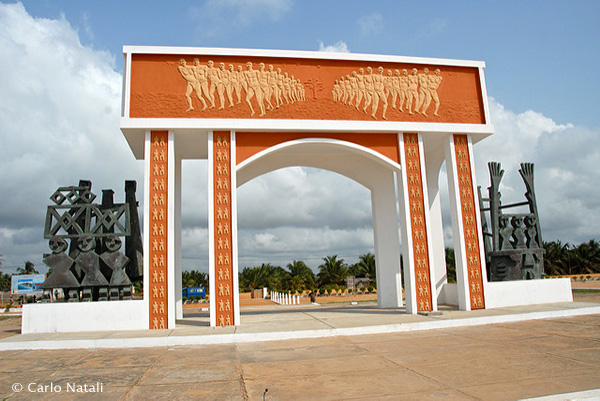

Meals: B - L - D
Overnight: Hotel Casa del Papa or similar (ocean front self-contained bungalows with air conditioning, salt water swimming-pool on the beach) - 3*
Day 5: Wild beaches & mask dances, Ouidah (100 km - 2 hr) - BENIN
The journey continues with a nice day “cruise” by pirogue along the Mono River. We reach an amazing estuary where the river meets the Ocean, we discover small villages where women still extract salt using ancient techniques, we enjoy pristine white sand beaches, we navigate through lagoons lined with small mangrove forests, we admire the large and artistically sculpted pirogues used by local fishermen …
In one village we will attend a Zangbeto Mask dancing performance. Zangbeto is a large mask, covered by colored straw. During the ceremony, the mask rises by means of acrobatic movements until it reaches a height of even 3 meters and then suddenly plunges to the ground and imitates the movements of a snake. Zangbeto or « the night-man » stands for non-human spirits, the forces of nature and the night who have inhabited the Earth long before man. The mask-wearers belong to a secret society and their identity is unknown to the uninitiated. Zangbeto usually lives in a convent and goes out when there are some disorders in the village. Basically, Zangbeto is a policeman, a judge for the village. Zangbeto may also exit during the day-light for “cleansing” the village. In this case he whirls around and just like a broom he delivers the village and the population of all ill things. People accompany the mask with singing and dancing and during the “exhibition” the adepts make « nujle-jle » (“miracles”), special demonstrations of skill and power which prove the force of Zangbeto.
Drive back to Ouidah where we can complete the visits and have some relax at the beach.
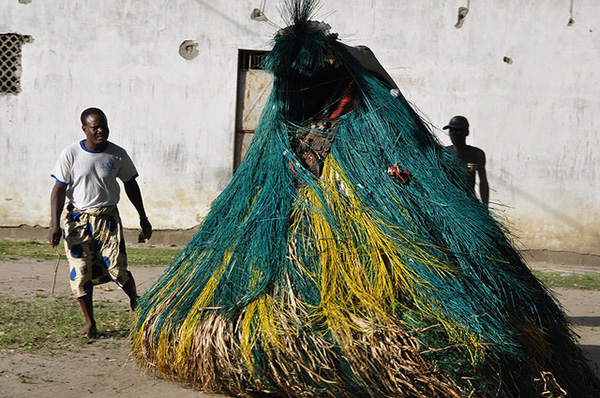
Meals: B - L - D
Overnight: Hotel Casa del Papa or similar (ocean front self-contained bungalows with air conditioning, salt water swimming-pool on the beach) - 3*
Day 6: In Voodoo Land, from Ouidah to Lomé (150 km - 4 hr) - BENIN & TOGO
Crossing of the Togolese border (Save Kodji / Hilla Kodji).
All along the coast of Togo and Benin, voodoo is a religion that has been passed on by the ancestors and is still fervently practiced. Although for many Europeans voodoo is only a vulgar form of black magic, in truth voodoo is a true religion, far richer and more complex than people often think. In a remote hidden village we will join a Voodoo ceremony: the frenetic rhythm of the drums and chants of the adepts help calling in the voodoo spirit who then takes possession of some of the dancers. They fall into a deep trance: eyes rolling back, grimaces, convulsions, insensitivity to fire or pain. Sakpata, Heviesso, Mami Water are just some of the voodoos divinities who can show up. In this narrow village, surrounded by the magic atmosphere of the ceremony, we will finally understand what people mean when they say: “In your Churches you pray God; in our voodoo shrine we become God!”
In another village, we will visit a healer, another special encounter with a person who “deals with” complex issues by giving solutions based on a very “simple” vision of human life. Their anthropology systematically associates material and spiritual worlds and therefore a physical disease is always treated assessing the patient’s spirit. The healer we visit cures his patients through the use of plants and the performance of sacrifices on the various shrines in his courtyard. We will have the opportunity to have a conversation with him and meet some of his patients.
Arrival in Lomé.

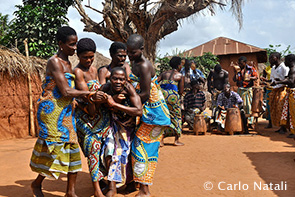
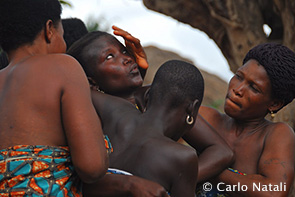
Meals: B - L - D
Overnight: Hotel Sarakawa or similar (all rooms ensuite and with aircon, Ocean front) - 3+*
Day 7: Fetish market, from Lomé to Akossombo (180 km - 4 hr) - TOGO & GHANA
Lomé, the vibrant capital of Togo, is the only African city which was a colony of the Germans, the British and the French. It is also one of the few capitals in the world bordering with another nation. These elements have led to the development of a unique identity reflected in the life style of its inhabitants and in the architecture of the town: Lomé is indeed a cross point for people, trade and cultures, a cosmopolitan city in small size. We will visit: the central market with its famous “Nana Benz”, women who control the market of the expensive “pagne” (=cloths) coming from Europe and sold all over West Africa (unfortunately the market has been partially destroyed by fire); the colonial buildings in the administrative quarter where the flavor of colonial time is still very present; and the fetish market where we can find an eclectic assortment of all the necessary ingredients for love potions and magical concoctions.
Lomé with its many galleries is an important trade center for tribal art, a real interesting place with shops for tribal art and antiques, craftworks, art galleries with contemporary paintings from the “Togolese school” (which start to be quite popular in French and North-American galleries), shops selling “popular” art items such as the colourful “advertising” signs in front of the street hairdressers etc.
Crossing the border with Ghana.
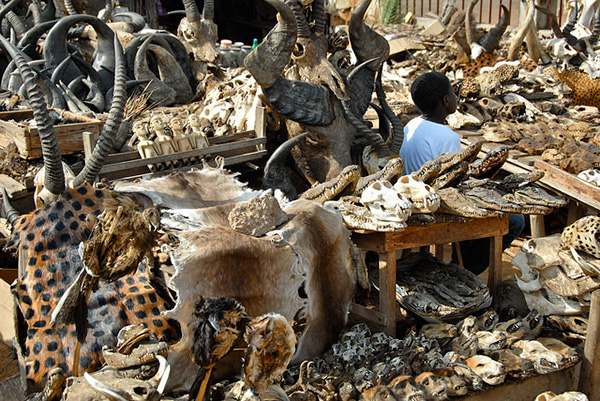
Meals: B - L - D
Overnight: The Royal Senchi Resort or similar (all rooms ensuite and with aircon, river front) - 4*
Day 8: Magic glass beads, Akossombo (100 km - 2 hr) - GHANA
We will visit the hilly region of the Krobo tribe, famous all over the world for their glass beads. Their precious beautiful handmade craftwork are produced and used for religious and aesthetic purposes. This century-old tradition is so well reputed that glass beads of Ghana are generally referred to as Krobo beads. The process involves different stages: scrap glass is first grounded into a fine powder then it is meticulously made into patterns and placed into hand-made clay molds covered in kaolin in order to be baked. Visit of a factory.
Stop at the Akossombo Dam, where we find the largest manmade lake in the world, with a shoreline measuring almost 5,000 km. Back to the hotel for a boat ride on the Volta River.

Meals: B - L - D
Overnight: The Royal Senchi Resort or similar (all rooms ensuite and with aircon, river front) - 4*
Day 9: The Ashanti, from Akossombo to Kumasi (250 km - 5 hr) - GHANA
We cross a region of tropical forest and late in the morning arrival in Kumasi.
Kumasi is the historical and spiritual capital of the old Ashanti Kingdom. The Ashanti people were one of the most powerful nations in Africa until the end of the 19th century, when the British annexed Ashanti Country to their Gold Coast colony. The tribute paid today to the Asantehene (=King) is the best evidence of their past splendour and strength. With nearly one million inhabitants, Kumasi is a sprawling city with a fantastic central market, one of the biggest in Africa. Every type of Ashanti craft (leather goods, pottery, Kente cloth) is found here, along with just about every kind of tropical fruit and vegetable.
The program includes a visit to the Ashanti Cultural Centre: a rich collection of Ashanti artifacts housed in a wonderful reproduction of an Ashanti house. In the afternoon, we participate - if available - in a traditional Ashanti funeral, attended by mourners wearing beautifully red or black togas. We say “funerals” but it means a “festive” celebration: the deceased in fact is believed to be still with his/her family and through this ceremony he/she becomes an ancestor. Relatives and friends gather, socialize and celebrate his/her memory. The chief arrives surrounded by his court under the shade of large umbrellas while drums give rhythm to the dancers whose intricate moves are highly symbolic.

Meals: B - L - D
Overnight: Golden Tulip Hotel or similar (all rooms ensuite and with aircon, Deluxe room) - 4*
Day 10: Golden Kingdom, Kumasi (50 km - 1 hr) - GHANA
In the morning continuation of the tour of Kumasi, with the visit of the Royal Palace Museum hosting a unique collection of gold jewels worn by the Ashanti court.
If applying, Akwasidae or Awukudae Festival
On the Ashanti calendar certain days each year are set aside for a very special celebration at the Royal Palace in Kumasi and this traditional ceremony takes place in one of the last African Kingdoms which has maintained its ancient rituals still alive.
During this celebration, the King sits under a spectacular colorful umbrella, is adorned in vivid cloth and massive centuries old jewelry (Ashanti gold jewelry and masks are considered masterpieces of African art) and is surrounded by the Ashanti elders and advisors, all under the authority of the Royal Speaker who holds in his hands the symbols of power. In front of the King a narrow passage of dignitaries is also formed, representing all roles and positions of power within the kingdom: sword and knife bearers, armed guards, carriers of beautiful ostrich feathers fans etc. The ceremony is then made up of a procession of royal court attendants bringing gifts, storytellers reciting the history of the Ashanti Kings, drummers & trumpeters playing horns of ivory. Corpulent dancers dressed in vivid red costumes perform an erotic dance. The mother queen also joins the ceremony accompanied by her attendants. We will witness and experience the splendor, the flavor and the atmosphere of one of last great African monarchs of the forests.
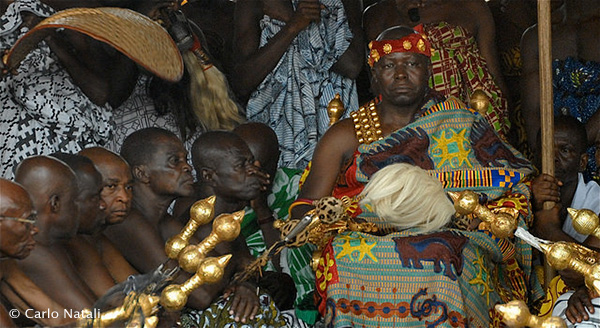
Meals: B - L - D
Overnight: Golden Tulip Hotel or similar (all rooms ensuite and with aircon, Deluxe room) - 4*
Day 11: Gulf of Guinea, from Kumasi to Elmina (250 km - 5 hr) - GHANA
In the morning, drive down along the coast to reach Elmina to visit castles and dungeons, remains from the ancient gold, ivory and slave trade. Elmina is a name linked to the history of Africa and to general world history. In 1482 Christopher Columbus and Bartolomeu Diaz arrived here with ten caravels to build a castle under Portuguese authority, the place having been chosen following the discovery of gold mines in the area. This is how the story of Elmina started: a castle, a port, a village - all in contact with Europe for more than five centuries. The Castle, the oldest European building in Africa, at different times has been used as a warehouse to trade gold, ivory, and eventually slaves. What we visit today is the result of successive extension works and is recognized as a UNESCO World Heritage site. The old Dutch Cemetery in Elmina goes back to 1806. Outside the castle, a wonderful fishing village with lots of large colorful fishing boats - every day these canoes are guided by skilled fishermen across strong ocean waves and currents, “fighting” to earn a living. In the old town we will see the Posuban, the shrines of the old “Asafo companies” - the warriors who used to put their offerings on the large colorful statues. The alleys in the old town have a very lively atmosphere, bringing us back to a time when Elmina was a busy colonial town.


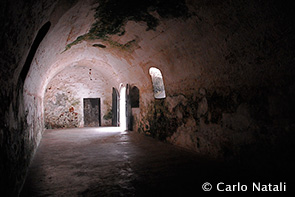
Meals: B - L - D
Overnight : Coconut Grove Resort or similar (all rooms ensuite and with aircon) - 3*
Day 12: Rainforest, from Elmina to Kakum and Axim (200 km - 4 hr) - GHANA
In the morning, we will experience the thrill of a “canopy walk” right in the deep forest of the Kakum National Park: one of the world highest suspended rope bridges held by steel cables. Perched 37 meters (120 feet) above the ground, you will enjoy a stunning view of the rainforest - instead of unveiling their trunks, trees will reveal their tops!
We move towards the most beautiful beaches of Ghana, with stops on the way at Butre and Dixcove. Butre is a lovely isolated fishermen village located on a narrow bay and at the top of the hill lie the ruins of Fort Batenstein from where we can enjoy a beautiful panorama. Dixcove is another attractive fishermen village with a fine-looking fort - Metal Cross Fort - overlooking the bay. Inherited from the Dutch defense, the fort enjoys its natural harbor.
Meals: B - L - D
Overnight : Lou Moon Lodge or similar (Island Executive room, all rooms ensuite and with aircon, boutique hotel)
Day 13: Lagoon, from Axim to Nzulezo and Axim (120 km - 3 hr) - GHANA
Nzulezo, an amazing village on stilts, can be reached only by pirogue, across a huge lagoon - the crossing itself would justify the trip! Completely surrounded by tropical vegetation and water, we are immerged in an incredible array of shades of green and blue, and the arrival at the village is a great surprise. The inhabitants are really friendly and they invite us to visit their homes - suspended on water - and tell us about their way of life.
In the afternoon return to Axim for some relax on the golden beach.
Meals: B - L - D
Overnight : Lou Moon Lodge or similar (Island Executive room, all rooms ensuite and with aircon, boutique hotel)
Day 14: Golden beach, from Axim to Accra (300 km - 5 hr) - GHANA
Half a day of relax on the beach and drive to Accra.
On the way, visit of Cape Coast Castle. Built by the Swedes in 1653, from 1657 to 1664 it changed hands many times as it was conquered by the Danes, the Dutch, the Fanti (a local tribe), the Swedes and finally the British. Today, it hosts a museum on the history of the slave trade.
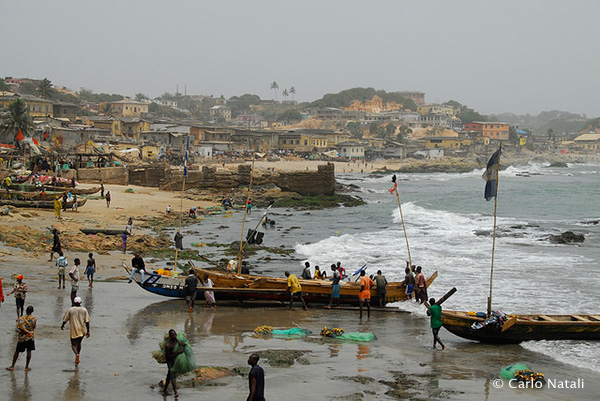
Meals: B - L - D
Overnight: La Villa Boutique or similar (executive suite, all rooms ensuite and with aircon, boutique hotel)
Day 15: African Metropolis, Accra out - GHANA
Accra, the capital of Ghana, has maintained its unique identity despite the fast-paced development currently underway in this intriguing African city. The luxuriant administrative area, punctuated with elegant villas built during the first half of the 19th century, reminds us that Ghana was one of the most flourishing British colonies in West Africa.
The program includes a visit to the National Museum (if open), one of the first works of independent Ghana - the idea inspiring the Museum is to relate Ghanaian art to the rest of the continent and to prove the existence of an African history as part of the general history of humanity. We explore the old quarter of James Town, inhabited by the local population known as the Ga. Facing the Ocean is where local native people life fully unfolds: a village surrounded by the city! Here all economic activities follow very different rules from the ones governing “the city” (business area), just a few hundred meters away. Our tour continues with the visit of a workshop where they specialize in building fantasy coffins. These special handcrafted coffins can reflect any shape: fruits, animals, fish, cars, airplanes…. the only limit being imagination! Started in Africa, these flamboyant coffin designs are by now collected worldwide and exposed in museums.
In the evening transfer to the airport for the flight out.

Meals: B - L
Day-use: La Villa Boutique, rooms in day-use till 18.00 hrs
Day 1: Maison Rouge or similar , |
 |
Day 2, 3: Residence Céline Hotel or similar, |
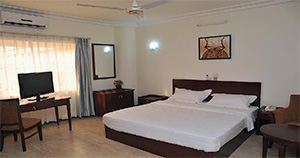 |
Day 4, 5: Hotel Casa del Papa or similar, |
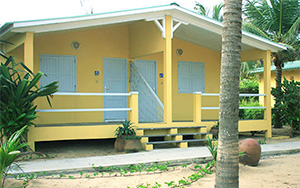 |
Day 6: Hotel Sarakawa or similar, |
 |
Day 7, 8: The Royal Senchi Resort, |
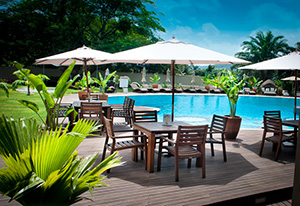 |
Day 9, 10: Golden Tulip Hotel or similar, |
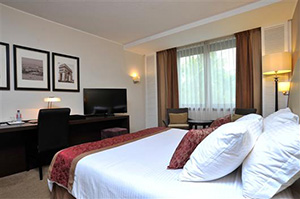 |
Day 11: Coconut Grove Resort, |
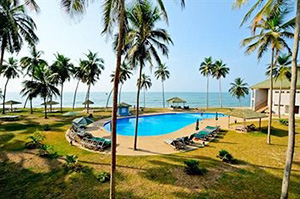 |
Day 12, 13: Lou Moon Lodge or similar, |
 |
Day 14: La Villa Boutique or similar, |
 |




